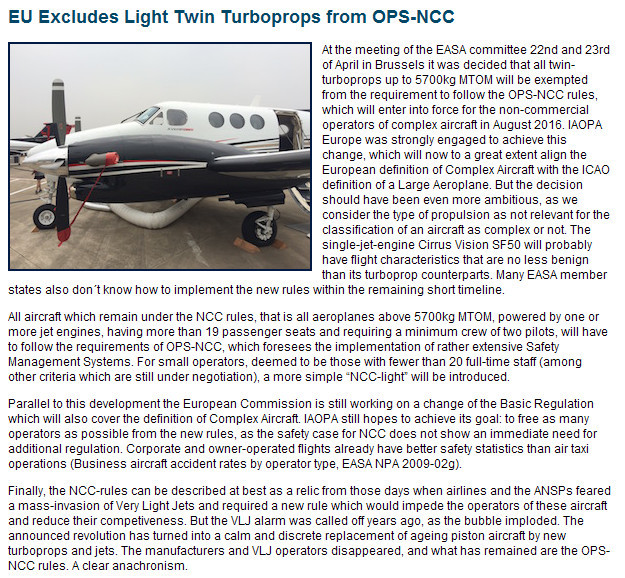This IAOPA article suggests so

Previously, the TBM and the PC12, both of European manufacture, had an “unfair advantage” against the King Air, in that ME turboprops could not be operated purely on State of Registry maintenance but had to have an additional EASA Part M “confirmation”. This was widely perceived as EU’s finger-up to the USA. It has not been adopted (yet) anyway.
EASA’s top guy for GA was at this year’s PPL/IR meeting in Coventry. A lot has changed in this organization, GA is represented up to the very top of the organization and they are trying to address GA’s needs as fast as they can, correcting all the nonsense and harm that the previous administration has done. It seems they want to catch up with FAA, reducing the regulatory burden. All in all, it was a very positive message.
Previously, the TBM and the PC12, both of European manufacture, had an “unfair advantage” against the King Air, in that ME turboprops could not be operated purely on State of Registry maintenance but had to have an additional EASA Part M “confirmation”.
Not sure what you are trying to say? A private King Air can be maintaind as as all other general aviation aircraft by a Part 66 engineer? Part 145 maintenance is only needed for those aircraft flying on an A to B AOC.
It is great to hear some positive news on behalf of GA in Europe.
Still, the classification of all jets as complex is pretty ridiculous really.
The new interpretation allows the Piaggio Avanti to be exempt from OPS-NCC but not an equal performing turbine aircraft without props and the same performance envelope, such as a Citation CJ1… What’s wrong with this picture?
Not sure what you are trying to say? A private King Air can be maintaind as as all other general aviation aircraft by a Part 66 engineer? Part 145 maintenance is only needed for those aircraft flying on an A to B AOC.
Sorry – I wasn’t clear. A NON EASA registered King Air would under previous proposals need an EASA Part M release to service in addition to the State of Registry release to service. More info here (one day I will update that writeup).
Nobody knew the exact final implementation of the Part M portion and there would have been many obvious questions e.g. a Part M company, with no A&P/IA available, has no competence (EASA-speak for authority) to release to service any aircraft which is not EASA-reg. So it would have been a pure money collection exercise; a social security network for Part M companies who would have probably just looked at the paperwork, enforced any lifed items etc, and charged nicely for it.
What’s wrong with this picture?
My guess is the “turboJET” aspect. Even in FAA-land, an aircraft needs a Type Rating if it is
It’s a very emotional thing…
Of course I am very happy that EASA is getting more pragmatic, but if I got a quid for every presentation in which a rep rubbished his predecessors, I would be flying a used but fairly good condition TBM700 now  So, time will tell.
So, time will tell.
Yes, that’s what the regs say, but it makes little sense.
The regs were written in the days when a turbojet was very likely a transport aircraft and needed a flight engineer to keep the engines running…
The regs were written in the days when a turbojet was very likely a transport aircraft and needed a flight engineer to keep the engines running…
Maybe in Europe, but in the USA you can fly a twin turboprop under 5700kg on a ME PPL or ME PPL/IR, with no TR.
Good news. EASA is fast becoming a beacon of hope in a sea of nonsense. Certainly much easier to certify airplanes and engines in EASA than it is FAA these days.
As for training – all they required from me was ‘insurance approved’ training in type (this does not have to be take-you-to-the-cleaners SimCom or Flighsafety) and then an IPC in type each year with a CFII. Very reasonable.
I don’t think it’s a bad idea to have a type rating for even small jets. Whilst they are basically easy to fly it can go wrong pretty quickly in one of these. The systems are a lot more complex than in MEP types, and they operate in a much more hostile environment.
As it happens I think a ME turboprop is arguably more of a handful, and maybe Europe has that one right too.